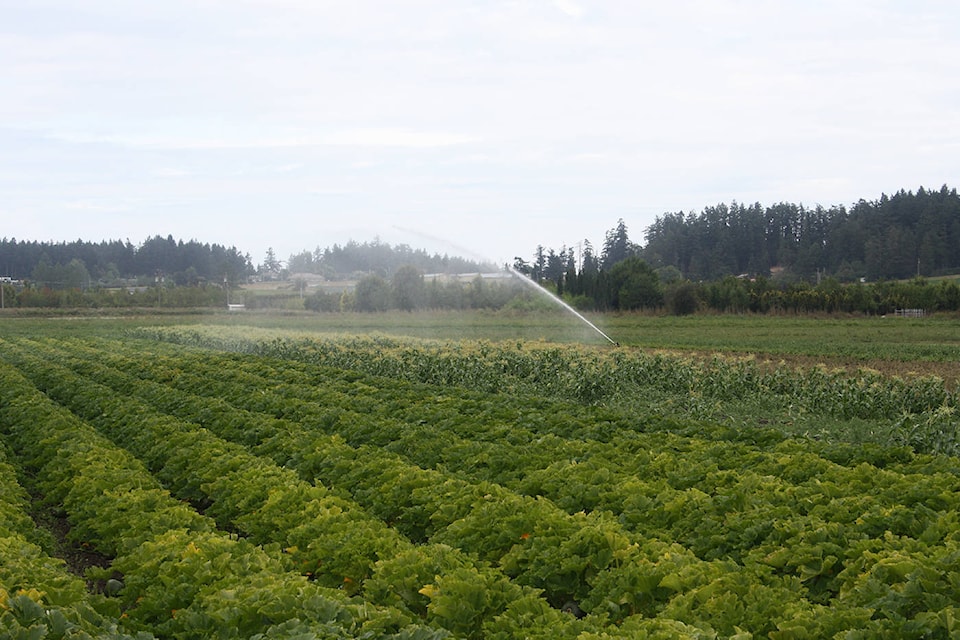Tim Collins / News staff
As climate change continues to impact the planet and discussions of its effect on the world rise in frequency and volume, it’s sometimes easy to view the issue through a theoretical lens, without recognizing an immediate impact upon our lives.
That is, unless you happen to be a farmer on the Saanich Peninsula and have spent the last three months looking to the sky for a sign of rain. But that rain has not come in a year that seems on track to becoming the driest in decades, with less than 0.7 mm of precipitation falling in July and August.
“This farm has been running for over 100 years and I’ve never seen anything like this. We’ve got our own irrigation pond with about 12 million gallons that fills up during the winter rains, but without it we’d have to be buying water and that can get expensive,” said Larry Sluggett of Sluggett Farms.
“We’re only farming about 80 acres right now, but without irrigation we couldn’t even do that. We’re pouring water on the fields every day right now.”
One of the farmers who is buying water from the CRD is Verne Mitchell of Mitchell Farms.
Mitchell’s operation is a landmark on the Saanich Peninsula and most years his 500 acre farm does not have to purchase any municipal water to maintain its operation.
“In an ordinary year we have reservoirs and springs on the property that provide water for about 60 per cent of our needs. The other 40 per cent of the moisture we need is generally provided by rain,” said Mitchell.
But not this year.
“We’ve been farming this land since my grandfather came here in 1860. We’re six generations in now and I can tell you that I have never seen a summer this dry. That 40 per cent of water we got from rain? We’ve had to buy that this year to keep the crops alive by irrigating.”
Mitchell is confident of maintaining his operation this year and in the immediate future, but worries about the impact on agricultural activity if the dry summers persist.
“We get our water from the Sooke Reservoir right now and, except for the expense that farmers pretty much have to pay from their own pockets, we can still operate. What happens in the future if that water isn’t available?” wondered Mitchell.
Trevor Murdock, a climate scientist at the University of Victoria’s Pacific Climate Impacts Consortium, explained that, while Mitchell’s concerns about continuing dry summers are well founded in current climate modelling, his fears of water shortages for irrigation are probably not.
“Overall, the models we have predict an overall increase in precipitation for the region although the droughts we’re seeing during the summer are likely to continue. I know it sounds contradictory but it really means that we’re likely to see far more extremes in precipitation events during the winter months followed by extended dry spells during the summer,” said Murdock.
A recent CRD report to which Murdock contributed, projects an increase of 31 per cent more precipitation on very wet days and an overall increase of five per cent in precipitation by 2050. In the same time frame, the amount of precipitation during summer months is predicted to decrease by 20 per cent and the duration of dry spells to increase by an identical amount.
“All I know is that the weather seems to be changing, and it’s making it harder for farmers to make a living. I irrigate in the morning and by nightfall the fields are dry again,” said Mitchell.
He also recounted a story from his youth during a drought that hit the Saanich Peninsula particularly hard and threatened the livelihood of area farmers.
“I remember it was a dry year, a year very much like this one and it happened back in the late ’40s. It was so dry and a lot of people back then didn’t have the irrigation systems we have now, so they were looking for anything they could do,” recalled Mitchell.
“Someone … I’m not sure who … came up with the idea of bringing in a rain maker. The fellow came in from Manitoba, I think, and he went up on Keating Ridge and he had this pendulum device that he was swinging back and forth, back and forth. Well, after three days and nights of swinging this pendulum, he packed up his things and left, saying the storms were too far away to call in,” laughs Mitchell.
“I’m not sure how much they paid him, or if her returned the money, but the rain never came … not because of this fellow anyway.”



